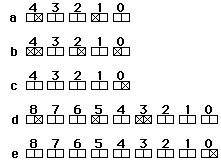
15. A 3-cell neighborhood automaton has the rule "the central cell is on in the next generation if either any 1 or any 2 of the cells in the neighborhood are on in the current generation." Write this rule in "0, 1" notation. Answer
16.[C] Use 1DIM to see what the rule in exercise 15 leads to for a single on-cell initial condition and for a random on-cell distribution.
17. A 3-cell neighborhood automaton has the rule "the central cell is on in the next generation if either any 2 or all 3 of the cells in the neighborhood are on in the current generation." Write this rule in "0, 1" notation. Answer
18. A 5-cell neighborhood automaton has the rule "the central cell is on in the next generation if either any 2 or any 4 of the cells in the neighborhood are on in the current generation." Write this rule in "0, 1" notation. Answer
19.[C] The outer totalistic rule Table 9.2d contains even more surprises than identified in Figure 9.12. Run 1DIM for that automaton starting with a random initial state, again and again. What variety of outcomes do you observe? Be patient, some surprises occur very rarely.
20.[C] Use 1DIM to evolve single cell and random initial configurations for the following 5-cell neighborhood, outer totalistic rules:
(a) if any 1 or any 3 are on ...,
(b) if any 1 or any 3 or all 5 are on ...,
(c) if any 2 or all 5 are on ...,
(d) if any 2 or any 4 or all 5 are on ... .
| 21. Write out in words the 2-dimensional automaton rules for the five scorecard codes below. |

|
22. Are the rules (c) and (e) of exercise 21 the same or different? Explain. Answer
23. Would any rule not containing the subrule "if 1 cell in the 2-dimensional neighborhood is on and the central cell is off then the central cell comes on" permit (interesting) growth from a single on-cell? Explain. Answer
24.[C] Since the number of possible rules using von Neumann and Moore neighborhoods is enormous and the number of different starting configurations almost limitless, exploration using 2DIM is likely to produce results never before seen by anyone else. Go exploring; maybe you will discover something startlingly new.
25. Voting rules are special cases of outer totalistic rules: for neighborhoods with an odd number of cells (all the examples we have considered satisfy this), the central cell becomes alive if more than half of the current neighborhood cells are alive. Write the outer totalistic formulation of the voting rule for
(a) one-dimensional 3-cell neighborhood automata, Answer
(b) one-dimensional 5-cell neighborhood automata, Answer
(c) two-dimensional von Neumann automata, and Answer
(d) two-dimensional Moore automata. Answer
26.[C] Use 1DIM and 2DIM to investigate the sort of patterns evolving from Random initial seeds for each of the four cases of voting rules (above). Answer
27.[C] Of course, some kinds of voting require more than a simple majority. Modify some of these voting rules to require a different number of live cells. Using 1DIM and 2DIM, note how the patterns evolving from Random seeds change as this required number of live cells is changed.
28. Parity rules are special cases of outer totalistic rules: the central cell becomes alive if an odd number of the current neighborhood cells are alive. Write the outer totalistic formulation of the parity rule for
(a) one-dimensional 3-cell neighborhood automata, Answer
(b) one-dimensional 5-cell neighborhood automata,Answer
(c) two-dimensional von Neumann automata,Answer and
(d) two-dimensional Moore automata. Answer
29.[C] Use 1DIM and 2DIM to investigate the sort of patterns evolving from Random initial seeds for each of these four cases of parity rules.
30. As you might expect, in Parity-Flip rules the central cell becomes alive in the next generation if an even number of the current neighborhood cells are alive. Repeat exercises 28 and 29 for parity-flip rules.
Return to Chapter 9 Exercises
Return to Chapter 9 Exercises: Cellular Automata
Go to Chapter 9 exercises: The Game of Life
Return to Chaos Under Control